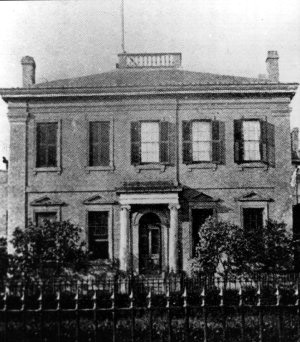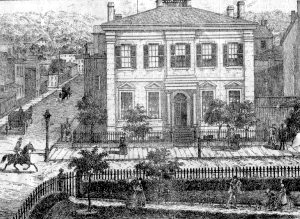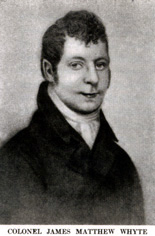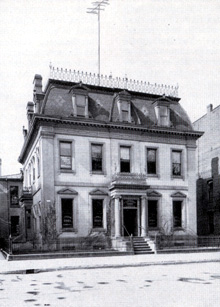GORE BANK

THE HEART OF THE CITY
GORE BANK
40-44 King Street EastThe Gore Bank, built in the 1840s, was located on the site of the modern bank building at the southwest corner of King and Hughson Streets. The Gore Bank was to serve the Hamilton and Gore District and was the first financial institution to be located on the Gore. Establishing the Gore Bank in 1833 was a rather difficult task. At that time, Hamilton was rather small; there were few people, no roads, schools or post office, and little or no industry. In addition to these problems, the Bank of Upper Canada, formed by an association between the Government and the Family Compact, had been established eleven years earlier, and provided sound competition for the Gore Bank. A formal application for the creation of the Gore Bank was filed in November of 1833 by Job Loder and 36 other prominent citizens. Allan N. MacNab fully supported the application, which was eventually passed in 1835.
(pre-1890 address 15 King Street East)Demolished
CURRENT STATUS (1999)
BUILDING INFORMATION
Date Built: 1840s
Original Owner: Gore Bank
Original Use: Same
Subsequent Uses: Same (Norwich Union Building, 1929; 10-storey bank,1977)ARCHITECTURE
Size: Two-storey building; roof added
Design and Style: British Greek Revival / Renaissance Revival
Architect, Builder: John G. Howard (architect)
Construction Material: Stone
Main Architectural Feature: Antique detailing; strip pilasters; wide flat entablature completed the Greek dressing; careful symmetry; Second Empire style mansard roof
 The
bank was granted a charter (a double liability clause) which made shareholders liable for
the debts of the bank caused by loss or deficiency in the capitol stock. Their total
liability was limited to double the stock held. A special clause in the charter prevented
corporations from holding stock in the bank. This was enacted to ensure that corporations
would not dominate the bank. At the time of its opening, the bank relied on proprietors
capitol stock and the circulation of notes to provide the greater part of the funds they
needed. Deposits were not a major financial contributor.
The
bank was granted a charter (a double liability clause) which made shareholders liable for
the debts of the bank caused by loss or deficiency in the capitol stock. Their total
liability was limited to double the stock held. A special clause in the charter prevented
corporations from holding stock in the bank. This was enacted to ensure that corporations
would not dominate the bank. At the time of its opening, the bank relied on proprietors
capitol stock and the circulation of notes to provide the greater part of the funds they
needed. Deposits were not a major financial contributor.
Throughout the 1840s and the decades to follow, the Gore Bank was of the most important financial institutions of the city, and at one time was the financial backbone of many Hamilton industries as much dependency was placed on the loan bank. The mid nineteenth century was a time of general prosperity in banking circles. Such prosperity allowed the Gore Bank to expand and establish branches in London, Guelph, Paris, Simcoe, and Woodstock.
 The
first president of the Gore Bank was Col. James Matthew Whyte, a former English Calvary
officer who in 1813 purchased land in Hamilton, eventually returning to the city to live
in 1823. He was succeeded by Colin Campbell Ferrie (1839-56), who was Hamilton’s
first Mayor. Andrew Steven, the first cashier of the bank became the third president and
Thomas Clark Street was the fourth president of the bank. The first Board of Directors
consisted of: Colin C. Ferrie, Edward Jackson, Michael Aikman, Edmund Ritchie, John Young,
James M. Whule, William Scott Burn, William Chrisholm, John Wilson and David A. MacNab.
The original solicitor of the bank was Allan N. MacNab.
The
first president of the Gore Bank was Col. James Matthew Whyte, a former English Calvary
officer who in 1813 purchased land in Hamilton, eventually returning to the city to live
in 1823. He was succeeded by Colin Campbell Ferrie (1839-56), who was Hamilton’s
first Mayor. Andrew Steven, the first cashier of the bank became the third president and
Thomas Clark Street was the fourth president of the bank. The first Board of Directors
consisted of: Colin C. Ferrie, Edward Jackson, Michael Aikman, Edmund Ritchie, John Young,
James M. Whule, William Scott Burn, William Chrisholm, John Wilson and David A. MacNab.
The original solicitor of the bank was Allan N. MacNab.
The first Hamilton office of the Gore Bank was located in a stone building on the south side of King Street West between MacNab and Charles Streets. It would occupy this building until 1844. The original building which housed the downtown branch of the Gore Bank, designed by John G. Howard, was constructed in 1838, and stood across from Gore Park on the south west corner of King and Hughson Streets. The building was a two-storey Renaissance Revival stone building with a Second Empire style mansard roof added in the 1870s. The exterior exhibited a careful symmetry. The antique detailing of the building was confined to the doorway where ionic columns flanked a fanlit doorway. Strip pilasters and a wide, flat entablature completed the Greek dressing of this standard elevation. The porch was designed with classical columns and a balustrade.
Up until 1854, the banking business of Upper
Canada was mostly in the hands of the Bank of Upper Canada, the Commercial Bank, the Gore
Bank, the Bank of Montreal, and the Bank of British North America. The Bank of British
North America proved to be a menace for the Gore Bank as it intended to have branches
throughout the provinces of British North America, while the local banks could not have
branches outside the particular province from which they received their Act of
Incorporation. Around this time, a number of new banks, which would assume positions of
importance, emerged, increasing the amount of competition. These would include: the Bank
of Toronto, the Ontario Bank, the Royal Canadian Bank, the Canadian Bank of Commerce and
the Commerce Bank.
October 26, 1869, the shareholders of the Canadian Bank of Commerce ratified the provisional agreement with the Gore Bank and in May of 1870, the Act of Parliament confirming the amalgamation received the Royal assent. Of the five banks that amalgamated with the Canadian Bank of Commerce, the Gore Bank is the only one that did not have an altogether successful career. Although its affairs were on the whole well administered, the Bank met with a series of misfortunes: the panic of 1837, the financial panic of 1857, the misfortune of conducting business with the United States during the American Civil War, and the failure of the Bank of Upper Canada with which it was a correspondent.
The premises at the southwest corner of King and Hughson Streets were bought by F. Kent Hamilton for the Goban Land Company and were supposed to be converted into stores. The approximate value of the sale was estimated at $200,000. As stated in the Spectator of April 22, 1929: "The Gore Bank building must give way to the modern store premises." The architecture for the second building was designed by Stewart McPhie. The original building was replaced by the two-storey Norwich Union Building in 1929, demolished in turn for the construction of the present day ten-storey banking building erected in 1977.
REFERENCES:
Clipping File – Banks and Banking –
Gore Bank. Special Collections, HPL.
Current Account, August 1963. Special Collections, HPL.
Encyclopedia of Canada, Vol. 3. Special Collections, HPL.
Head of the Lake Wentworth Bygones. Special Collections, HPL.
Herald Scrapbook, Vol. B4. Special Collections, HPL.
Public Archives Canada, C-54256. Special Collections, HPL.
The Hamilton Centennial. Special Collections, HPL.
